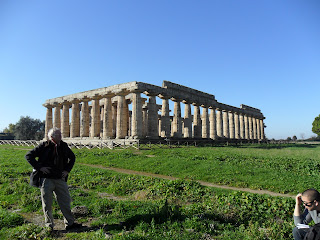I didn’t die this past weekend and I’m quite proud of that. It was another weekend spent with Professor Jan Gadeyne (the Wall Walk leader), and he prepped us with words similar to, “Some of you may die on this weekend’s Death March.” But we all survived! My Roman History class went on a three day excursion to the cities and ruins of Terracina, Minturnae, Cuma, Boscoreale, Pompeii, Paestum, and Naples. I will try to make the following post as concise as possible, but I’m warning you that it may be long and that the history nerd in me will most definitely surface. Here we go!
On Friday we left Rome at 6:45 a.m. and arrived in Terracina a couple of hours later. We learned that Terracina became a Roman colony after shuffling between Roman and other groups’ control for a few centuries. The function of a Roman colony was to act as a base for further conquering and to allow Roman influence to spread. We learned how the forum was the center of public Roman activity and about the Appian Way, the Roman road that actually ran straight through Terracina. There’s a lot more I could say, but I don’t want to bore you all to death.
 |
| Temple of Anxur |
After Terracina we followed the coast down to Minturnae. Here we learned about veteran colonies. These were colonies the Romans created in order to have places for veteran soldiers to live. We walked inside the ancient theater and learned about the Capitolium. Each city had one of these in the forum area and modeled them after the temple to Jupiter that was on the Capitoline hill in Rome.
 | |||
| Appian Way |
Following Minturnae we stopped for lunch and I had a Caprese sandwich (mozzarella and tomato). Our journey took us to Cuma next, where we learned about its’ Greek origins. In fact, it was one of the most important Greek settlements for trade and commerce and is located in a strategic place along the Bay of Naples. It later became inhabited by the Samnites and finally the Romans. This is also the city where it is thought that the cave of the Sybil in the Aeneid is located. Cuma was the last stop for the day with the exception of traveling to Paestum to get to our hotel. It was a really quaint place right on the beach that fed us pretty well. We had a very traditional Italian dinner that included pasta as the first course and pork and potatoes as the second course. Salad and fruit always follows the first and second course in order to "cleanse the palate."
On Saturday we got up to have breakfast and then journeyed to Boscoreale to have a look inside an antiquarium. We saw remains from Pompeii and an excavated farmhouse, but everyone’s favorite was the molds of dead people. Giuseppe Fiorelli invented a recreation technique by filling in the voids of decayed items with plaster, so it is possible to see shapes of people who died during the eruption of Mt. Vesuvius. This then led us five minutes down the road to Pompeii where we spent the entire day. I’ll spare you the entire lecture and just put up my pictures.
 |
| Mt. Vesuvius |
 |
| Forum |
 |
| Temple to |
 |
| Ancient Graffiti |
 |
| Cast of a dog from the explosion |
When we returned to Paestum for the night we had another traditional Italian meal, only this time it was a lot more…coastal. After the first course of pasta they brought out a second course of calamari in red sauce. My first encounter with this dish will hopefully be my last! While I am always willing to try anything and I didn’t really have a choice without being impolite, I did leave the tentacles on my plate and only the rings of the body were eaten. Dessert was a traditional Neapolitan sfogliatella.
Sunday morning we visited the city of Paestum where we saw very well preserved Greek temples. Paestum was originally Greek and was actually called Poseidonia. The following are pictures of these temples, dedicated to Zeus, Hera, and Apollo . Eventually Rome conquered this city.
 |
| Professor Gadeyne in front of Temple to Athena |
At the conclusion of our trip we went to Naples, a place where I have no desire to return. Professor Gadeyne kept telling us that the beauty of Naples is behind everything you see, but since I was only there for a few hours I just saw what I saw. And that was a bunch of trash and crazy insane drivers. I believe I nearly died ten times! While in Naples we learned about the history for a little and then went in search of lunch. Naples is the capital of the margherita pizza, so we went in search of a pizza shop. After lunch we left for home and returned around 6 p.m. It was certainly an exhausting trip, but I have never learned more in one weekend than I did this time!


the geographer in me loved this post! Lots of great pictures and a super history lesson:)
ReplyDeleteGreat Cindi! I'm glad you enjoyed it! :)
ReplyDelete